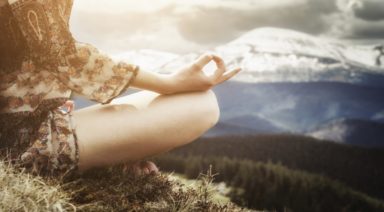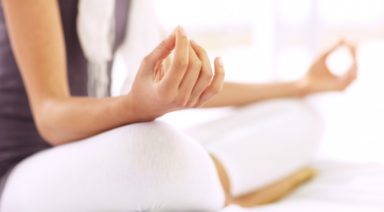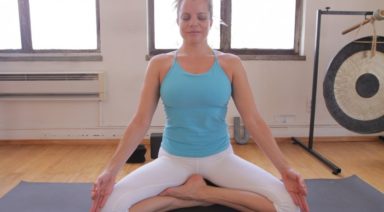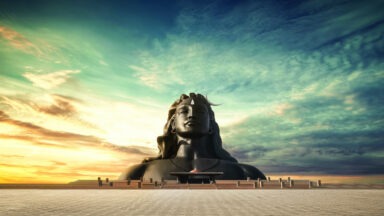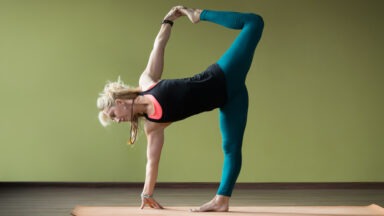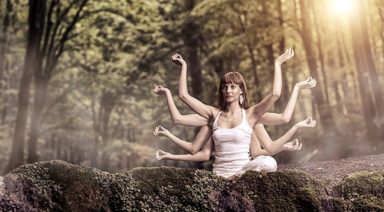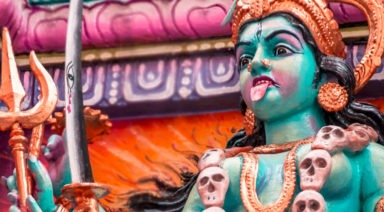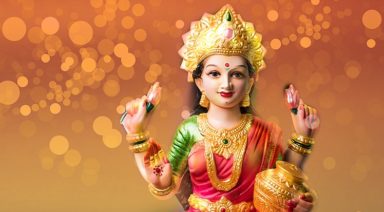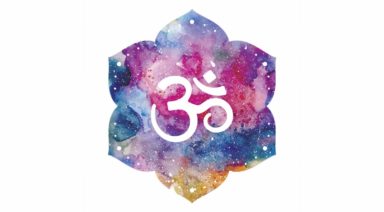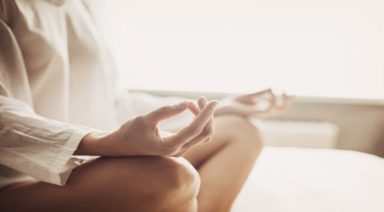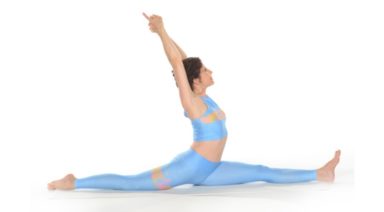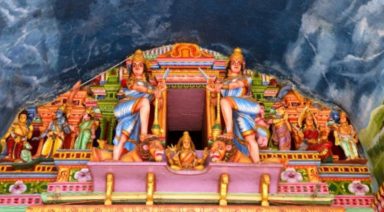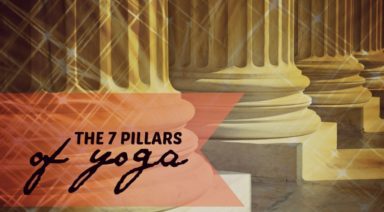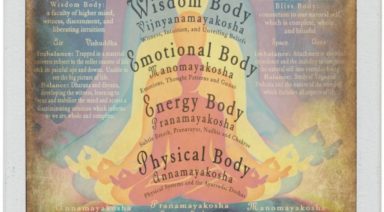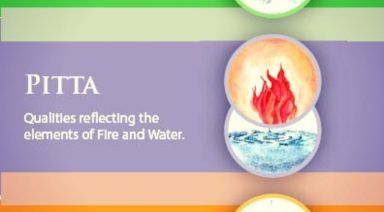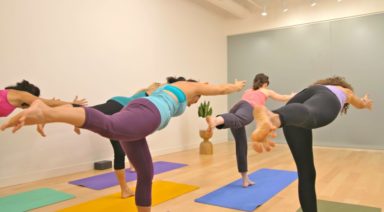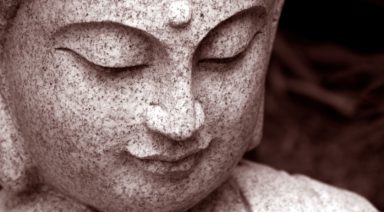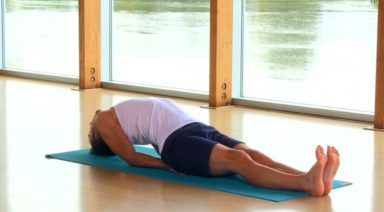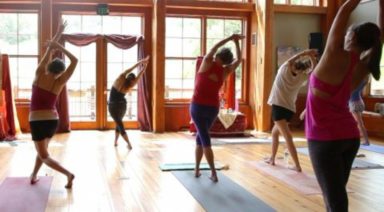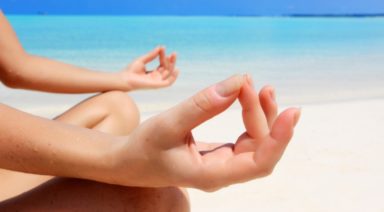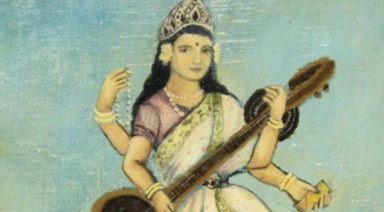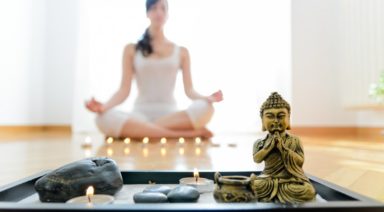What’s in a Mantra?
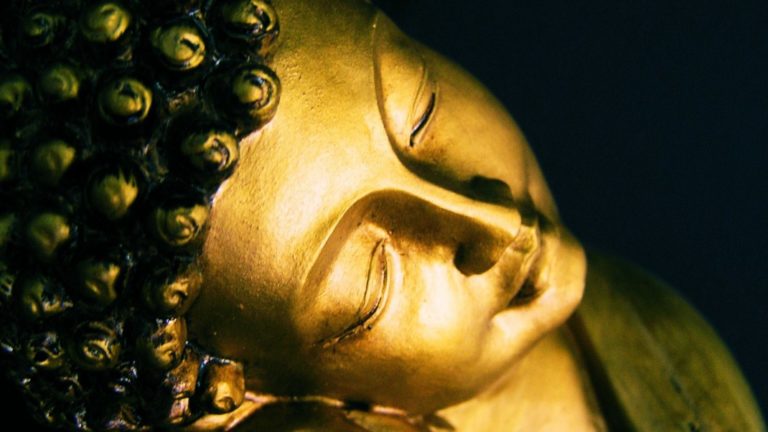
Most yogis know that chanting Om is chanting a mantra and that the word mantra comes from two Sanskrit words: man meaning mind; and tra meaning vehicle or instrument – a tool to transport the mind from a state of activity to one of stillness and silence. We get the words train, travel, and transportation from the Sanskrit root tra. But Om is not simply a word – it’s a seed sound known as a bija – heralding all of the unbounded universe in its very utterance. So let’s dive into the deep end of the mantra pool!
Most mantras are comprised of the fifty letters of the Sanskrit alphabet and can consist of a single letter, a syllable or string of syllables, a word, or a whole sentence. Typically, most mantras are sounds, syllables, or vibrations that don’t necessarily have a meaning. Their value lies in their vibrational quality, not in any meaning that humans, society, culture, or civilization has placed on them over the last few thousand years. For this reason they go beyond the state of human existence on this planet, and they take you deeper because they are vibrations that have existed since the dawn of creation.
The Hymn of the Universe
Om – often referred to as the hymn of the universe – is considered the ultimate vibration because it contains every vibration that has ever existed and every vibration that will ever exist. It’s pure yoga – union. Just as white light contains all the colors of the spectrum, Om contains every sound in the vibrational spectrum – even those we can’t hear with our ears. The cover of Pink Floyd’s Dark Side of the Moon represents this brilliantly as it shows the white light coming into a prism and all the colors of the spectrum coming out the other side. The same could be said for Om – it’s the white light of sound.
Historically, Om is first mentioned in the twelve verses of the ancient Vedic text the Mandukya Upanishads, which explains the three basic states of consciousness: waking, sleeping, and dreaming. In its original spelling and pronunciation, AUM (pronounced ahh-uhh-mmm) is a blending of those three states of consciousness into the one-ness of three distinct syllables: A, U, and M. These three vibrations also represent the three stages of life: birth, living, and death.
The vibration A (pronounced ahh, like the sound you make opening your mouth for the doctor) represents the waking state and the beginning of all things. The letter A is the first letter of most every alphabet, the first letter of the Rig Veda, the Koran, Homer’s Odyssey – even the New Testament! The vibration A heralds creation…the beginning. Vedic sages refer to it as the a-kara and it represents the realm of form and shape – the physical realm.
The vibration U (pronounced oo) is referred to as the u-kara and represents the dream state, the realm that is devoid of form or shape – the realms of air, water, fire, dreams – ever-changing aspects of the formless world around us.
The vibration M is known as the ma-kara, which represents the state of deep sleep – neither form or formless like the other two realms but beyond shape or shapelessness – the realm of consciousness in hibernation, waiting to unfold.
In Sanskrit grammar, when the letters A and U are combined in writing, they are translated as the letter O. That is why we so often see Om written instead of Aum. Over thousands of years, the writing of Aum has taken a back seat to Om, and that has led to Om being the sound that is most often chanted by both Western students and teachers of yoga, meditation, and Vedanta.
When the three individual vibrations are combined, a fourth vibration is created like a chord in music made up of individual notes. AUM (pronounced ahhh–uhhh–mmmm) represents the fourth state of consciousness – transcendent consciousness or turiya – what we call enlightenment or one-ness. In Vedanta, it’s the unity of the divine made up of its three components: creation; preservation; destruction (and rebirth). The chanting of this mantra heralds our universality, which is why we usually chant Om before and/or after meditation and yoga practice, and when we read sacred, ancient texts. By repeating a vibration or sound over and over, it will become part of your physiology; it will become your mind; it will become *you. * It will lose all meaning, all definition, and all relevance. There will be no separation between you and the vibration that is resonating right now.
Chanting Om (out loud or silently) is an ideal reminder of our universality.
How to Use Mudras to Regulate the Five Elements of Your Body
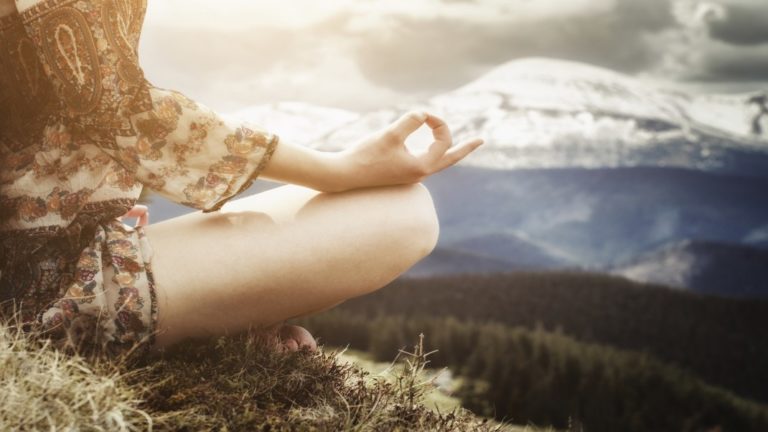
Many cultures from around the world, including those based in China, Japan, India, and elsewhere, believe the Universe is comprised of specific elements. You are likely familiar with the four most common elements of earth, air, fire, and water. Some traditions, including Indian philosophy, Hinduism and Buddhism, add ether or space as the fifth element. According to these groups, humans are tasked with keeping these elements in alignment in the Universe, on earth, and within ourselves.
- Earth, or bhumi in Sanskrit, corresponds to anything solid. For instance, in your body earth elements include skin, bone,hair, teeth and organs.
- Air, or pavan in Sanskrit, is believed to be the highest of all the elements. Within the body, your breath is the air element.
- Fire, or agni in Sanskrit, serves as a source of warmth. The heat from our breath and other parts of our body correspond to this element.
- Water, or jala in Sanskrit, is critical to the survival of all living things and as such is one of the most important elements to keep in balance. All of the liquids in our bodies stem from this element.
- The great unifier of the elements is Ether, known as aakash in Sanskrit. Ether is thought to bring the other four elements together and allow them to prosper.
It is thought by some that the imbalance of these elements on Earth can cause natural disasters from drought to earthquakes to wildfires. Similarly, the belief is that if these elements are misaligned within a human body, this can lead to disease and other ailments. For the treatment of imbalance within oneself, performing specific mudras are often recommended.
Before you begin to diagnose which elements might be weak or imbalanced, try to identify which element is your greatest strength. For example, I am a Leo, which means my element is fire. Knowing this can direct me towards my area of strength and power. What is your element?
What are Mudras?
From the Sanskrit word mudra, mudras are symbolic hand gestures used in Hindu or Buddhist religious ceremonies and in the practice of yoga. Occasionally these gestures are done with the whole body, but more often they are focused on the hand. While I will be focusing on the mudras from the Buddhist and Hindu religions, you can find mudras in almost every culture. They can be found in meditation, yoga, the hand gestures in ethnic dancing – think Indian or Flamenco.
My preference is to practice madras while sitting in a cross-legged position on the floor with plenty of back support. However, they can be practiced while sitting, lying, standing, walking or even talking. Moreover, you only need five minutes to practice your mudras, but for best results upwards of twenty minutes is suggested. Which means you have no excuse not to give one a try!
For me, the practice of mudras is meditation with specific hand movements. For those of you that struggle with meditation, this practice is a good gateway into more formal meditation. You sit relatively still and allow our mind to slow, but you can keep your mind somewhat active as your focus on the hand gestures. This is especially good for mudras that have your alternate between different positions.
If you already have a regular meditation practice, you may already be using a mudra and not realize it. For instance, if you meditate by sitting in a cross legged position with your thumb and index finger connected so they form a zero and your other fingers extended and your hands placed palms-up on your thighs, then you are performing a classic Chin Mudra. This mudra focuses on your breathing. By sitting and holding your hands in this way you are activating your diaphragm and creating a healthy flow of oxygen in and out of your body.
The Basics of Mudras and the Five Elements
- Mudras for the earth element will include your ring finger
- Mudras for the air element will incorporate your index finger
- Mudras for the fire element will include your thumb
- Mudras for the water element will incorporate your pinky or little finger
- Mudras for the ether element will focus on your middle finger
Mudra for Balancing Energy
A good place to start when diving into mudras for element alignment is this mudra for balancing energy. It incorporates each of the five elements by including each finger in the process.
If you are feeling “off” and are looking for a quick fix that you can do from anywhere, this is it. You can even take five minutes at your desk to perform this mudras during the day or take a few minutes before going to bed at night.
It is a set of four mudras or hand gestures. First, on both hands simultaneously, touch the tips of your thumb and index finger together and hold for approximately five seconds. Then, move your thumb to your middle finger and hold that connection. Continue to your ring finger and lastly your pinky. Do several rounds of this until your breathing has slowed and you are ready to return to your day or drift off to sleep.
Mudra for Arthritis or Parkinson’s
Simply called Vayu, this mudra is recommended for those suffering from arthritis or Parkinson’s Disease. This is not a cure, but might help in addition to your other treatments and medications. Press the index finger on the base of thumb and keep the thumb on the index finger. Let the other fingers be straight. Do this for several minutes.
Mudra for Increased Strength
Named the Prithvi Mudra, this simple gesture aims at increasing your physical strength. Join the tip of the thumb and ring finger and hold for several minutes. Your other fingers should be pointing outwards.
Mudras for Balancing Emotions
These mudras are aimed at helping adjust an emotion that is overwhelming you in some way. Notice that each finger corresponds not only to an element, as discussed above, but also to emotions and internal aspects of your body. In order to affect either the emotion or body part, squeeze the corresponding finger on both sides.
- For emotions relating to fear or issues related to the kidneys, activate your little or pinky finger
- For emotions relating to anger or issues connected to the liver, gall bladder, or central nervous system, activate your ring finger
- For dealing with the emotion of impatience or the heart, small intestine, circulatory and respiratory systems, activate your middle finger
- For emotions relating to depression, sadness, and grief or issues with the lungs, activate your index finger
- For dealing with the emotion of worry or anxiety or for reoccurring stomach issues, activate your thumb
For me this guidance triggers a few thoughts. First, the close connection between anxiety and the stomach make complete sense to me. Whenever I am feeling super anxious, my stomach very quickly becomes my enemy. I also find it amusing – albeit in a sophomoric way – that the middle finger corresponds to impatience. Lastly, I think about individuals who imbibe in too much alcohol and how when the liver is in overdrive, so then is their ability to regulate the emotion of anger. Do you see any other connections that you can make either in your life of in the lives of your friends and family?
The Connection Between Mudras and Yoga
A lesser known type of yoga is called Yoga Tatva Mudra Vigyan. It incorporates select mudras into a more sedentary yoga practice, similar to meditation. The yoga texts that describe this branch of practice are the Hatha Yoga Pradipika and Gheranda Samhita.
One example of a mudra that lends itself to yoga is the Brahma Mudra. This mudra is known for relaxing the nervous system, reducing snoring, and increasing lung capacity.
In the exercise, you first must put your hands into the Adi Mudra. In Adi Mudra, the thumb is placed at the base of the small finger and the remaining fingers curl over the thumb, forming a light fist. Now, that you are in Adi Mudra, turn the knuckles of both hands together the hands facing upward are placed at the navel area. It is important when practicing any yoga mudra to take at least twelve deep breaths. The longer you hold this pose and observe your breath, the greater the outcome.
Recommendations
If you haven’t already tried out some of these mudras while reading this article, here are some next steps. First, decide if you would like to work with mudras in your yoga practice, meditation, or if there is a specific mudra that meets your needs.
For a more formal approach to incorporating mudras, here is a quick video that demonstrates a few easy mudras, I think Faith does a great job of walking you through the basics. Once you have progressed through her lesson, the next step is to try this longer video. Think of it as a whole class. You will feel so good afterwards and have a much better understanding of mudras and how they can be applied.
Also, now that you are getting more in touch with your hands, there are specific exercises you can do to take care of them.
While I suggest starting with the videos to learn the poses, after that you are free to explore on your own. I really like mudras, because unlike meditation and yoga, which are best practiced in a quite space, mudras can be practiced at any time. They can be added into your day in a more organic way. You can pick a mudra for stressful meetings and another one for before drifting off to sleep.



